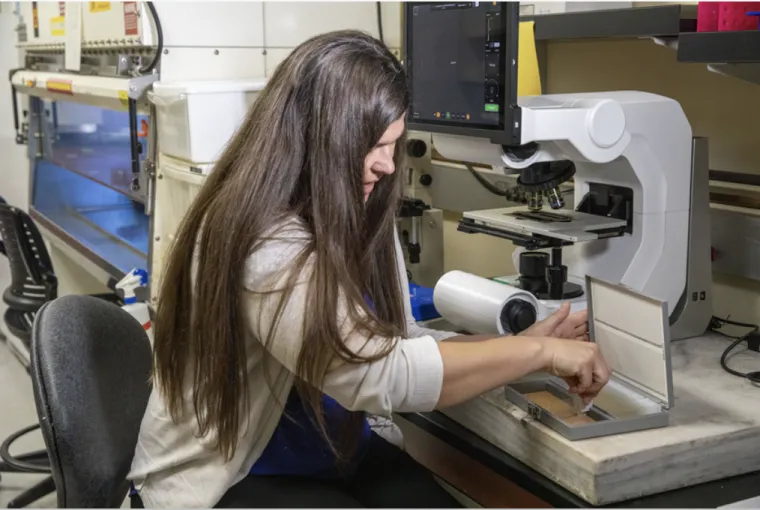<
Conversations with Rising Stars
TALLY LARGENT-MILNES
As associate professor of Pharmacology, Tally Largent-Milnes serves as co-director of the Center for Excellence in Addiction Studies Behavioral Core. Her research focuses on trigeminal synaptic physiology, neuropathic pain and rational design of multifunctional compounds to treat chronic pain. Understand why migraine is more than just a headache in our Conversations with Rising Stars…

What initially attracted you to the current focus of research?
I have been interested in pain and the interlinked drugs of abuse for the last twenty years. I’m curious as to why some people have higher pain tolerances than others. Having witnessed the impact of chronic pain on family, I started my scientific path and moved from whole-body pain, specifically traumatic injury pain, to facial pains, and now to migraine. Within the field of pain, we still don’t know what a headache is, beyond symptomatology, despite it being the 3rd most prevalent neurological disorder and the 7th most debilitating disease globally. Most migraineurs are female. My active research program seeks to understand the “how” and underlying mechanisms by which migraine is initiated, transitions to chronicity, the sexual dimorphisms of presentation and drug responsivity in migraine, considering the role of hormones, evolving pathology, risk factors such as chronic medication use, and currently reported interventions, such as Cannabis. Embedded in these questions, we look at potential side effects and adverse outcomes of current interventions and target validation for new therapies to improve migraine pain management across the lifespan.
How have collaborations impacted my work on campus?
Collaborations are critical for my work on campus. I had a unique experience of “growing up” as a scientist as a research member of a project grant. As a graduate student, I saw the value of interdisciplinary and interprofessional management of research projects. In my own lab, I have continued to foster collaborations for the good of the project, as the most rigorous science is a team approach integrating experts across fields. I serve as co-director of the Center for Excellence in Addiction Studies Behavioral Core within the Comprehensive Center for Pain and Addiction (CCPA). This allows me to learn what others are doing, provide services in which I am an expert and facilitate connections to my peers for future collaborations.
Research breakthroughs take time, so what keeps you motivated in your daily duties?
So true, research breakthroughs take time. I find that my daily motivators or my “whys” are two-fold. First, I am heavily inspired by and invested in my students and lab members. Building relationships with them and watching them grow in their careers is gratifying, and I frequently learn a lot. Second, I love analyzing data. I see each piece of data as a puzzle piece that brings the bigger picture into focus.
What about your experience at the U of A makes you want to continue your career as a Wildcat?
I have spent the majority of my career at the University of Arizona, and I love the outdoor and cycling opportunities in Tucson. I completed my B.S in 2005 in biochemistry and molecular and cellular biosciences, and my PhD in medical pharmacology in 2010. I returned as faculty in 2014 to my current department, which is ranked 4th in the Blue Ridge ranking and retains world-renowned pain and neuropharmacology researchers. Continuing at UArizona means I can continue to interact daily with innovative colleagues in the CCPA, College of Medicine, and across campus who provide both scientific and emotional support.
When you describe your research to someone for the first time, what’s one major point you hope they understand?
Migraine is more than just a headache, and its pathology changes over time. This make effective intervention a moving target.

